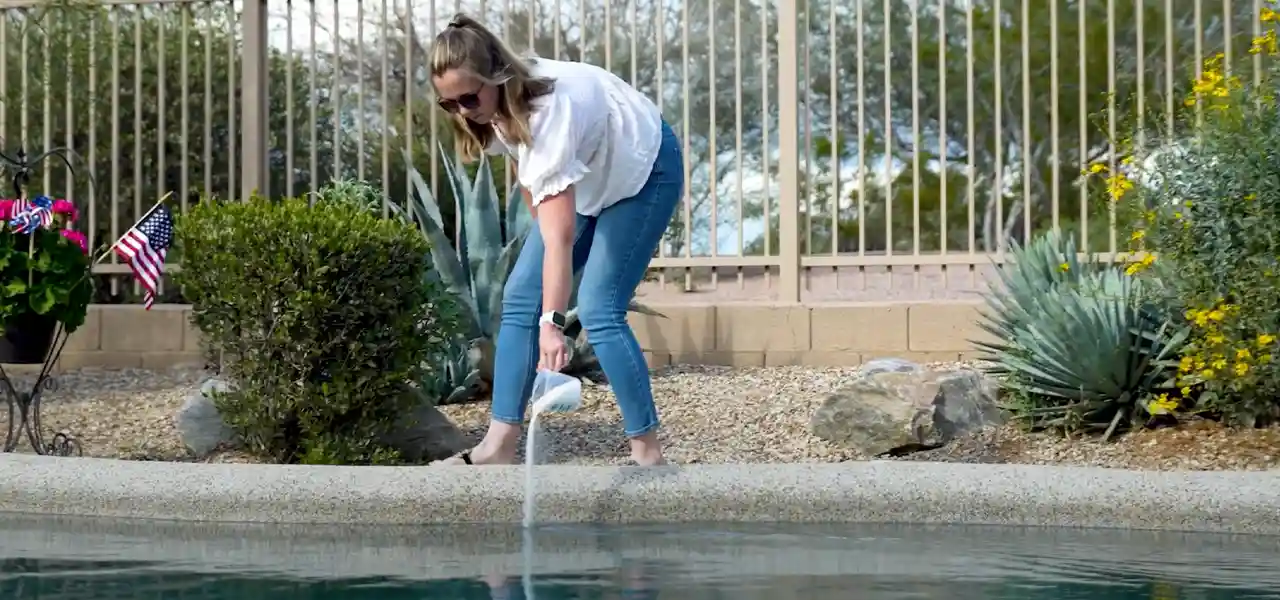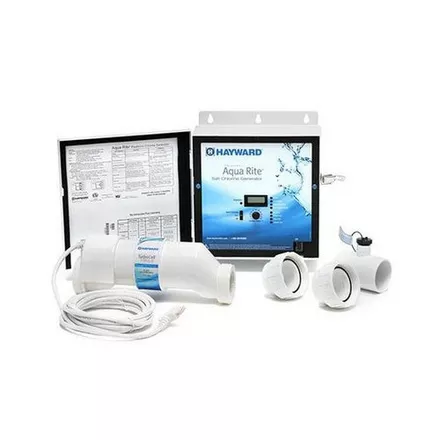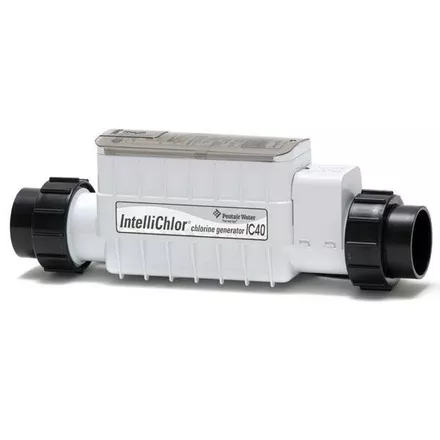Saltwater pools use regular table salt to create chlorine, by passing the slightly salty water over two electrically charged plates, called the salt cell. Salt systems are also called salt chlorinators or chlorine generators. After the chlorine has fought the good fight, disinfecting the water, it returns again to salt, and the process can begin all over again. But what about shocking a saltwater pool? Can you use the salt cell to shock, or should you use pool shock? And what type of pool shock is best for a salt pool?
When to Shock a Saltwater Pool
In regards to how often to shock a saltwater pool, it’s no different from other chlorine pools. There are 3 valid reasons for shocking a pool, to remove chloramines, remove algae, and remove contaminants.
- To remove chloramines. Test your pool water with a DPD test kit, or test strips, that test for both Free and Total Chlorine. If the Total Chlorine test is noticeably higher than the Free Chlorine test, shock the pool heavily to remove the combined chlorine molecules (Chloramines; Total Chlorine – Free Chlorine = Combine Chlorine). When the chloramine level is 0.3 ppm or higher (just a bit darker on the Total Chlorine test), it’s time to shock the pool – to remove the buildup of combined chlorine.
- To remove algae. Chlorine is a great algaecide, and is the best way to quickly remove algae – whether you have small spots in out of the way places, or a very green pool. For isolated spots of algae, scrub them hard with a steel bristled brush, and sprinkle chlorine granules over top of the area (plaster pools only). You can also scrub blue/green and black algae heads with a Trichlor chlorine tablet. For an all-over algae bloom and green water, balance the chemistry and shock the pool heavily, to kill algae, and restore a blue-ish color to the pool.
- To remove contaminants. If your pool is contaminated with bodily fluids, organic materials, or heavy use — shock the pool heavily to remove anything that could fuel algae growth or stain the pool. Heavy oil or soap contamination is best treated first with an enzyme to bring it under control, followed a few days later by shocking.
Granular pool shock can also be used in a saltwater pool to remove surface stains caused by organic materials (leaves, worms, dirt). It is useful to raise chlorine quickly, if the level has dropped dangerously low, or when pool equipment (pump, filter, salt system) is not working properly, and is unable to create chlorine.
How to Shock a Saltwater Pool
Just like any other chlorine pool, shocking a saltwater pool is no different. Follow these steps:
- Balance the chemistry: Before you add shock to the pool, it’s important to test and adjust (if needed), your pH, Alkalinity, and Calcium Hardness levels. If pH is high, chlorine is very slow to react, and less potent. If Hardness levels are also high, crystalline deposits could form. If metals like copper and iron are high, shocking the pool can cause a temporary (sometimes permanent) staining. Be sure to test your level of cyanuric acid (stabilizer), and if over 20ppm, add 50% more shock. If over 40 ppm, double the dose.
- Calculate the dosage: Adding the correct amount of shock is important if you are trying to kill full-scale algae blooms or remove chloramines from the pool. If you do not add enough, to reach “breakpoint chlorination”, approximately 30 ppm – the result will not be complete. If using granular pool shock (cal-hypo), use 3 lbs per 10000 gallons for a complete shock that will kill anything in the pool. If using 6% liquid chlorine bleach, add 5 gallons per 10000 gallons.
- Add the shock: With the filter system running, and the pH on the low side, 7.2-7.4, add the chlorine (granular or liquid) slowly to the pool, dispersing it around the pool edge, or broadcasting the pool shock over the surface. Vinyl pools, painted pools, and fiberglass pools should pre-dissolve cal-hypo shock by pouring 1-2 lbs at a time, into a 5 gallon bucket filled with water. Stir it with a stick until dissolved, then pour it around the pool edge, being careful to not allow undissolved granules at the bottom of the bucket to slip into the pool.
You can turn down the salt cell production at this point to a low level, as the shock will probably last a few days. Test the chlorine level the following morning, and it should still be sky-high. If not, that means something consumed all the chlorine, and another shocking of the pool is in order.
Can I Use My Salt Cell to Shock the Pool?
Even though many salt chlorinators have a super chlorinate or shock button, using your salt cell to shock the pool places a heavy demand on the salt cell, shortening its lifespan. In addition, most salt systems placed in “shock mode” will only raise the FC level by a few clicks – up to 5-7 ppm. It also does it very slowly, which will not have the desired effect of killing algae, removing chloramines or pathogens.
Unless your salt system is extremely oversized for the pool size, such as a 50000 gallon salt system on a 15000 gallon pool – the shock feature is best used for superchlorinating purposes, and not for shocking the pool. Super-chlorinate after rainstorms or heavy pool use, but for algae, chloramines or contamination, you will need to use packaged pool shock.
In summary, shocking a saltwater pool is no different than shocking any other chlorine pool. Despite what the sales brochures or salesman said, a salt chlorinator does not replace the need for chemicals, including occasional use of chlorine products.








